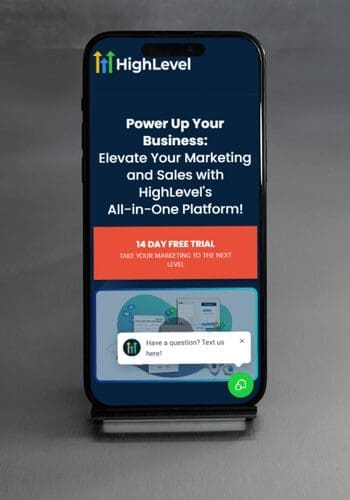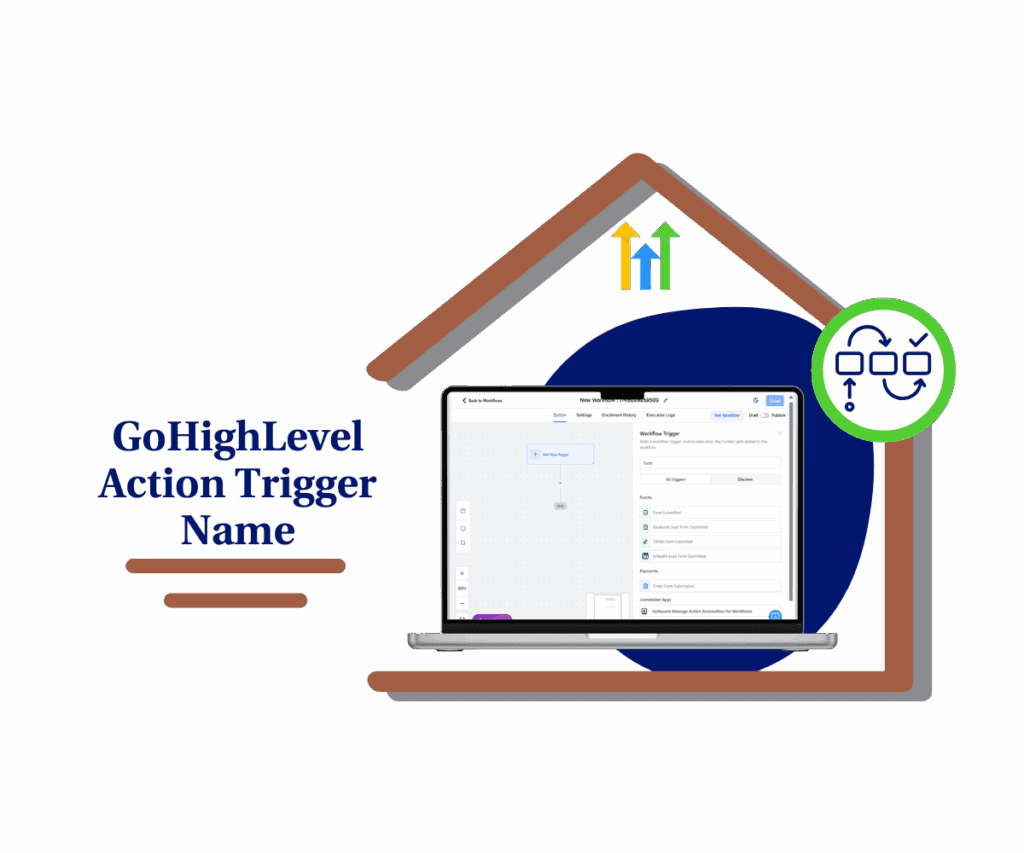- Send data to Zapier, external CRMs, or apps with seamless webhook triggers from inside GHL
- Quick Summary – Webhook Automation Essentials
- Why Webhook Automation Matters
- What’s New – Native Webhook Action in Workflows
- Real Use Cases for Webhook Triggers
- How to Use – Setup Webhook Automation in GHL
- Pro Tips to Maximize Webhooks
- What This Means for Your Agency
- Results You Can Expect
- Frequently Asked Questions – Webhook Automation in GHL
- Conclusion – Webhook Automation Made Simple
Send data to Zapier, external CRMs, or apps with seamless webhook triggers from inside GHL
Want to automate your CRM like a boss? Webhook automation inside GoHighLevel workflows lets you send data to Zapier, Google Sheets, or any external platform the moment a lead fills a form or books an appointment. It’s fast, direct, and zero code.GoHighLevel has unlocked a powerful new layer for workflows: native webhook triggers.
Now you can automate complex data transfers between systems without writing scripts or juggling spreadsheets. If your agency juggles multiple tools, this feature is a game-changer. Inside the workflow builder, you can now trigger a webhook the second a form is submitted, an appointment is booked, or any key action happens. Just drop in the URL from Zapier or another platform, and boom—data exported instantly.
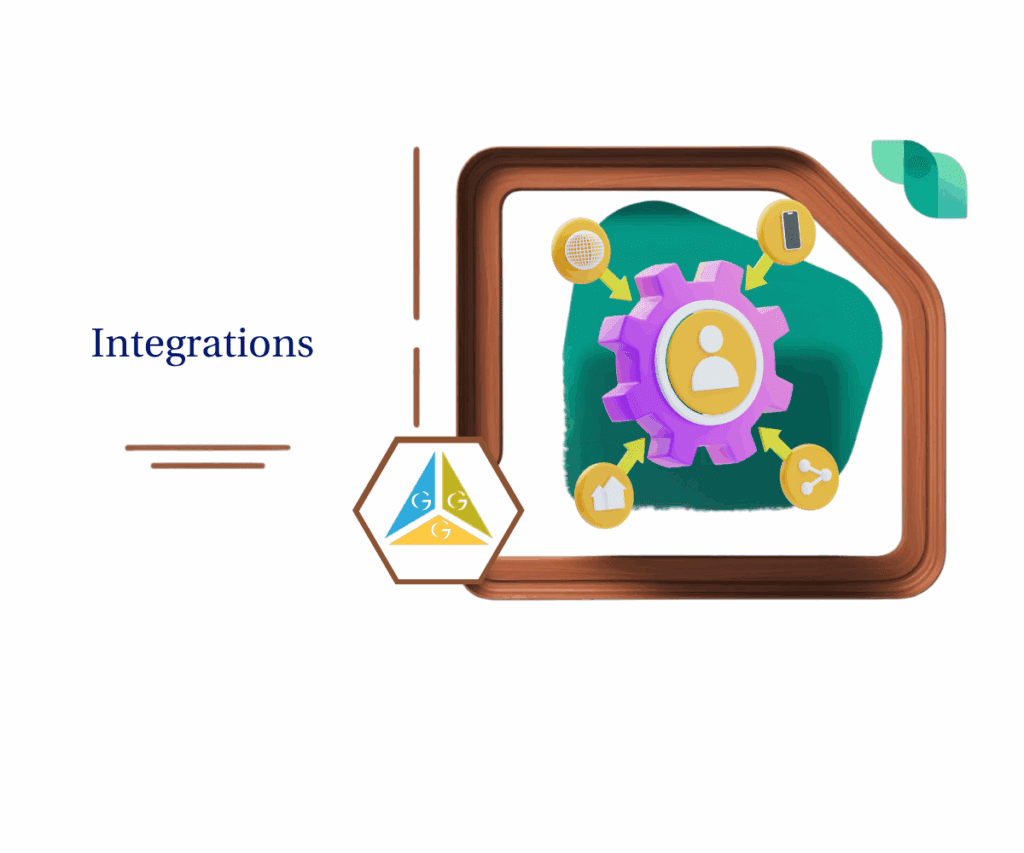
With webhook automation built into GoHighLevel workflows, you can instantly sync data with Zapier, CRMs, or external tools—saving hours and streamlining your entire client process.
Quick Summary – Webhook Automation Essentials
This blog post walks you through how to set up webhook automation in GoHighLevel workflows so you can instantly send lead or customer data to external platforms like Zapier, Google Sheets, or CRMs. It explains how to use workflow triggers to fire off webhook actions that connect GHL with your other tools, automating your entire data flow. You’ll learn why this feature matters, what it unlocks for agencies, and how to implement it step-by-step. It includes real-world examples like sending form submissions to Slack or syncing appointments to project boards. This automation saves time, reduces manual entry, and creates cleaner systems across your tech stack.
Purpose: Teach users how to connect GoHighLevel to other platforms using webhook automation
Why It Matters: Automates cross-platform data sharing without code
What You Get: Step-by-step guide to triggering webhooks inside workflows
Time to Complete: Setup takes about 5–10 minutes per workflow
Difficulty Level: Beginner to Intermediate
Key Outcome: Faster lead processing, clean automation, fewer errors
Why Webhook Automation Matters
If you’re still manually exporting lead data or juggling CSVs between platforms, you’re wasting precious time—and risking mistakes. Webhook automation eliminates that mess. It gives your GoHighLevel workflows the power to trigger external actions in real time.
Automate marketing, manage leads, and grow faster with GoHighLevel.
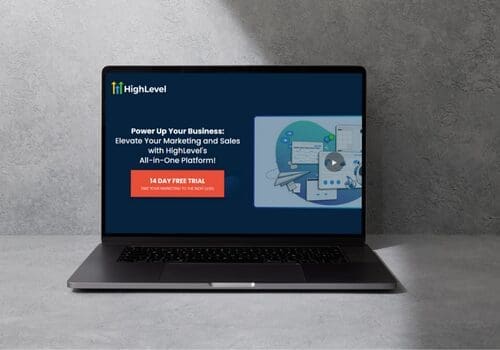
Let’s say a lead books a call. You want that info in your Google Sheet, your reporting dashboard, and your email tool. With webhook automation, one workflow action in GHL can push that data everywhere it needs to go. Automatically. No more back and forth.
For agencies using multiple tools—like Airtable, Trello, Slack, or third-party CRMs—this feature is a major upgrade. You don’t need to rely on integrations being built into GHL. Webhooks open the door to any platform that accepts incoming data.
It also keeps your data clean and your processes consistent. No copy-paste errors, no leads slipping through cracks, and no hiring devs to build out your tech stack.
Bottom line: Webhook automation inside workflows helps you move faster, connect smarter, and scale cleaner.
What’s New – Native Webhook Action in Workflows
GoHighLevel now lets you add webhook calls directly inside any workflow. No hacks. No extra apps. Just one smooth native action that instantly sends your data wherever it needs to go.
Inside the workflow builder, you’ll find a new action: Webhook. When triggered, it fires off a POST request to whatever URL you plug in—Zapier, Make, Pabbly, or any webhook-compatible service. You define the trigger (like form submitted or appointment booked), and GoHighLevel takes care of the rest.
Here’s what this means:
- You don’t need devs to sync GHL with other platforms
- You don’t need workarounds or delays between tools
- You can build entire cross-platform systems from inside GHL
This isn’t just about sending data. It’s about giving GHL users complete control over how, when, and where their workflows connect across the tools they use every day. From lead routing to onboarding to campaign coordination—this single action unlocks serious automation potential.
Real Use Cases for Webhook Triggers
Webhook automation isn’t just for tech geeks—it’s pure gold for agencies and marketers who run multi-platform setups. If you’re using GoHighLevel alongside tools like Zapier, Google Sheets, Slack, Airtable, or Notion, this one action can glue it all together.
Here are some real-world use cases that make webhook triggers shine:
1. Form Submissions → External CRMs
Let’s say a new lead fills out a GHL form. Instantly push that data to HubSpot, Zoho, or any other CRM using a Zapier webhook. No double-entry. No delay.
2. Appointment Bookings → Google Sheets
Need a clean spreadsheet of booked appointments for your client? Trigger a webhook when a meeting is scheduled, and send it straight to a live-updated Google Sheet.
3. Surveys → Slack Alerts
Got a post-call survey? Webhook that data into Slack for your team to get real-time feedback. It’s fast and keeps everyone in the loop without logging into GHL.
4. Sales Pipeline Moves → Project Management
When a deal hits “Closed Won” in your pipeline, fire a webhook to kick off a new Trello card or Asana task automatically.
5. Lead Qualification → Multi-System Sync
Tag a lead in GHL and webhook that signal to a separate tool—like your email list manager or ad retargeting platform.
The beauty of webhooks? One trigger. Infinite outputs.
How to Use – Setup Webhook Automation in GHL
Setting up webhook automation in GoHighLevel is easier than you think. Once you know where to click and what to paste, it takes just a few minutes to connect your GHL workflows to any external tool.
Step 01 – Access the Main Left Hand Menu in GoHighLevel
- The Main Menu on the Left side of your screen has all the main areas that you work in when using GHL
1.1 Click on the Automation Menu Item.
- Access the ‘Automation’ section of GoHighLevel
- You’ll now be in the ‘Automation’ section of GHL, where you can access the “Workflow” section from the top menu:
1.2 Click on the ‘Create Workflow’ menu link.
- On the Drop down menu click start from the scratch

Step 02 – Set Up the Trigger for Your Workflow
2.1 Click Add Trigger at the top of the workflow.
2.2 Choose a trigger like:
- Form Submitted
- Survey Submitted
- Customer Booked Appointment
- Or any event that kicks off your process.
- For the sake of this mini guide we will Use “form Submitted”
2.3 Click Save Trigger to lock it in.
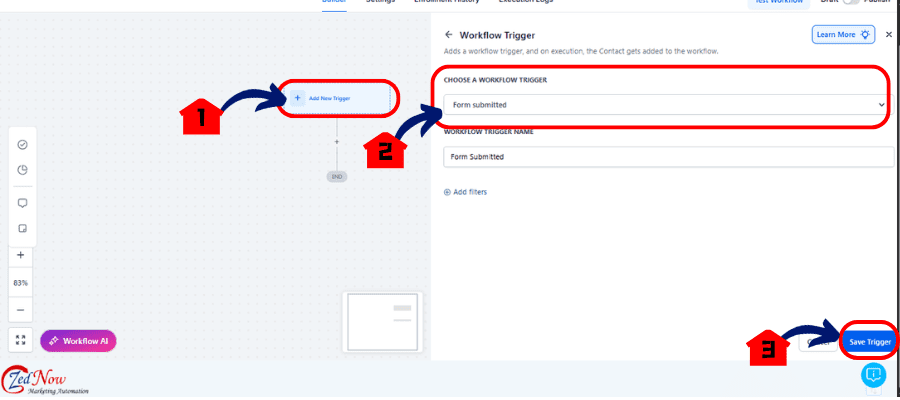
Step 03 – Add the Webhook Action
3.1 Click the + button right below your trigger.
3.2 In the action list, select Webhook.
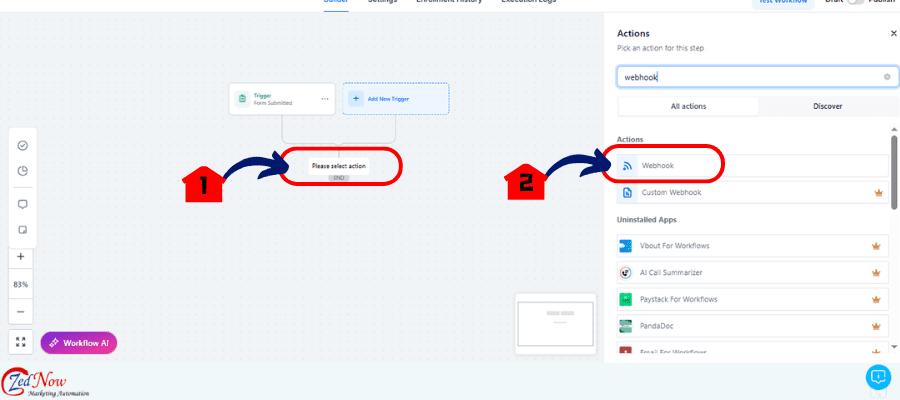
3.3 Fill out the Fields
- Action Name – Give a name for your Webhooke (e.g. Send To Zapier)
- Method – “Post” means Sending Data, While “Get” Means Retrieving Data
- Webhook URL – “Paste the Webhook Url” from Zappier this will be your key to integrate GHL to other Platform
3.4 Click Save Action to finish.

That’s it. You’ve just linked GoHighLevel to another system—instantly and automatically.
Pro Tips to Maximize Webhooks
Once you’ve got basic webhook automation running, it’s time to dial it in like a pro. These tips will save you time, help with troubleshooting, and make your integrations bulletproof.
1. Name Every Webhook Clearly
Don’t just call it “Webhook 1.” Use clear names like “Send to Slack – Lead Booked” or “Push to Airtable – Survey Response.” This helps you find and debug fast.
2. Always Test Before You Launch
Use Zapier’s test trigger function before activating any automation live. It confirms data is being sent and received as expected—without surprises.
3. Use Custom Fields for Context
If you’re passing lead info, include fields like tags, pipeline stages, or source. This makes the data more useful when it lands in other systems.
4. Use Filters in Zapier
Don’t send every webhook to the same zap. Use filters in Zapier to route leads differently based on form, tag, or status in GHL. Cleaner workflows = fewer headaches.
5. Check Webhook Logs
If things break, go to the Workflow Execution Logs in GHL or your zap history in Zapier. You’ll see what was sent, when, and whether it was received.
6. Time Your Triggers Smartly
Don’t trigger a webhook the moment someone fills a form if you’re going to tag or score them afterward. Add a delay of 1–2 minutes if needed to ensure clean data.
7. Duplicate Workflows for A/B Testing
Want to test different routing strategies? Clone your workflow and use different webhook URLs to compare performance between tools.
These little tweaks take your webhook automation from basic to badass.
What This Means for Your Agency
Webhook automation transforms GoHighLevel from a CRM into a true operations hub. With just a few clicks, you can push data where it needs to go—without needing developers, custom integrations, or third-party tools slowing you down.
Think of your workflows as the central nervous system of your agency. With webhooks, each action in GHL can trigger a ripple effect across your tech stack. Need a new client in GHL to appear in your proposal software? Want booked calls to auto-update your project board? All of that just happens. You’ll move faster, look smarter to clients, and reduce your dependency on tools that don’t talk to each other.
More importantly, this keeps your data consistent and actionable. You won’t have to wait for zaps to run. You won’t need a VA cleaning up spreadsheets. It’s automated, clean, and instant. And if you’re scaling? Webhook automation gives you repeatable systems that don’t break when you double your lead flow.
Results You Can Expect
Once webhook automation is live in your GoHighLevel workflows, you’ll start seeing results fast—like within hours. The whole point is to free up your team, tighten your processes, and create systems that scale without manual input.
Here’s what users typically experience:
1. Faster Lead Handling
Leads move instantly between GHL and your other platforms. No waiting. No “Hey, did that lead show up in Airtable?” moments.
2. Smoother Onboarding
As soon as someone fills a form or books a call, your onboarding systems get the signal. You can launch email sequences, populate welcome docs, or start tasks without lifting a finger.
3. Better Reporting
Send data to Google Sheets, dashboards, or analytics tools automatically. No more stale spreadsheets or hunting down lead info.
4. Fewer Errors
Removing manual steps cuts out the biggest source of errors: humans. Webhook data is clean, consistent, and fast.
5. Happier Clients
You’ll look like a tech genius when everything flows seamlessly. Faster updates, quicker responses, and cleaner processes = more trust.
The takeaway? Webhook automation isn’t just about sending data. It’s about speeding up your entire business.
Frequently Asked Questions – Webhook Automation in GHL
Conclusion – Webhook Automation Made Simple
Webhook automation inside GoHighLevel isn’t just another fancy feature—it’s a force multiplier for any agency or business owner juggling multiple systems. It turns your workflows into command centers, firing off actions across the tools you already use without writing a single line of code.
You’ve now seen how to set it up, why it matters, and what kind of real-world results it delivers. From instant data syncing to smoother onboarding to cleaner dashboards, webhooks are the silent workhorses of serious automation.
The team here at GHL Growth Garage loves this feature because it gives users full control—without tech headaches. It’s flexible, fast, and frees your team to do more of what matters.
Have you tried out webhook automation in your workflows yet? Drop a comment and tell us what you’re syncing—we’re always curious how agencies are leveling up with this one.
Scale Your Business Today.
Streamline your workflow with GoHighLevel’s powerful tools.
